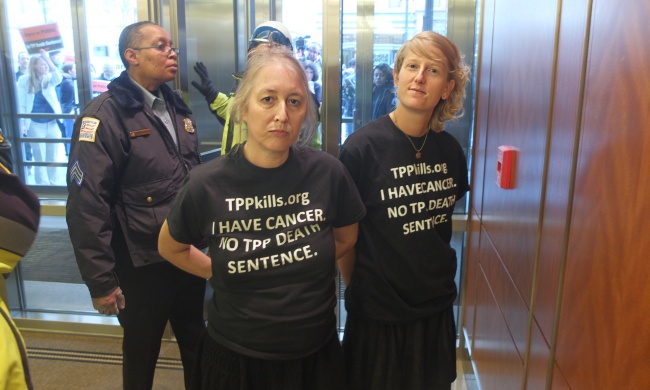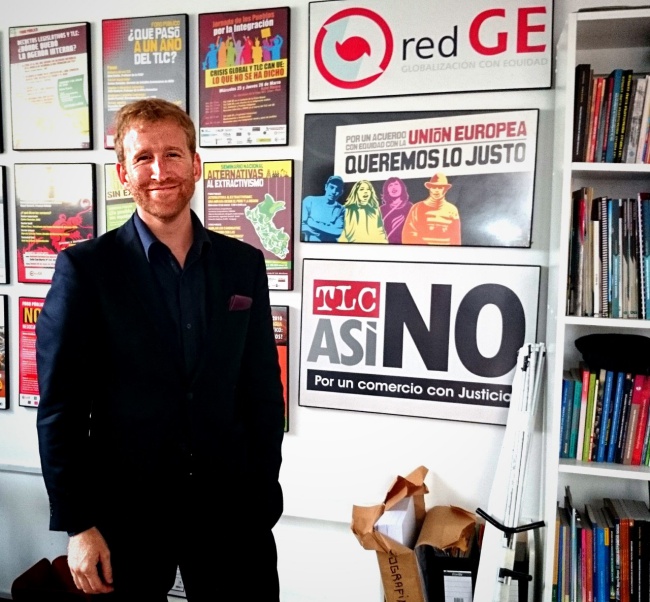How a Battle over Affordable Medicine Helped Kill the TPP
TRADE, 21 Nov 2016
James Trimarco – YES! Magazine
The debate about an exotic new kind of drug delayed the trade deal for years, thanks in part to relentless advocates who stood up to big pharma.

Cancer patients Zahara Heckscher and Hannah Lyon engage in civil disobedience at the headquarters of the industry group PhRMA in Washington, D.C., on February 4. Photo courtesy of Public Citizen.
18 Nov 2016 – Amid the fallout from Donald Trump’s election is the end of the Trans-Pacific Partnership. After six years of negotiations, the controversial trade deal is dead.
Its proponents were caught off guard. Just a week before the election, U.S. Trade Representative Michael Froman was telling CNBC that members of Congress were ready to pass TPP right after the election. “If they bring it forward,” he said, “I think we can get the votes there.” But Trump had made withdrawal from TPP a cornerstone of his campaign. After his victory over Hillary Clinton, Republican leaders in Congress made it clear that the deal was going nowhere.
That’s a serious setback for President Barack Obama, who was its highest-profile advocate. “This will end up being the most progressive trade bill in history,” Obama said last year. “It will have the kinds of labor and environmental and human rights protections that have been absent in previous agreements.” Yet, hardly any labor or environmental groups supported it. The AFL-CIO federation of unions and the Sierra Club, for example, were outspoken opponents.
Less well-known is the small, international group of affordable-medicine advocates who undermined its passage in a years-long drama that pitted consumer advocacy against corporate interests. By relentlessly pointing out how proposals by the United States Trade Representative would hike drug prices, says Brook Baker, a professor of law at Northeastern University who’s written widely about trade, those advocates helped delay the deal long enough to make it vulnerable to political attack.
“If this had been brought up two years ago, [Congress] probably would have passed it,” Baker says. “One of the sticking points was intellectual property—and that was mainly over concerns about access to medicine.”
The health advocates Baker is talking about—groups like Doctors Without Borders, Public Citizen, and Oxfam—didn’t have a seat at the negotiating table. And they couldn’t see the deal’s secret text. But by allying themselves with other countries in the partnership, they were able to build trust among people who did have seats. Then, they provided information and did whatever they could to shore up resistance among negotiators.
“At each round, civil society went and found out what was on the table, and got negotiators who were thinking alike to talk to each other,” Baker says.
********************
It was February 2011, and Peter Maybarduk was in Santiago, Chile, for round five of negotiations for the TPP. He works for Public Citizen, a D.C.-based advocacy organization, where he directs a group that focuses on fair access to medicines. By that time, he says, he’d pretty much given up on changing anyone’s mind on the U.S. side. But he was hoping he could help persuade the negotiators from other countries not to sign off on a deal he thought would increase the cost of health care for their people.
The negotiations were being held at a law school, but only trade ministry representatives and other government officials were allowed in. Representatives of civil society, like Maybarduk, had to wear special badges and stay out of the rooms where the deal’s secret text was being hammered out.
That left Maybarduk and other advocates wandering the halls, hoping to grab a Vietnamese or Peruvian negotiator and pull them aside for a chat. Trying to influence the process in this way could get dicey. Maybarduk remembers infiltrating a presentation given by officials in the Chilean government, when someone with the U.S. contingent said something like, “I thought only trade representatives were allowed in here.” He pointed at Maybarduk and said, “He’s not.” Outed, Maybarduk got up and left the room.

Peter Maybarduk visits the office of the Network for Globalization with Equity (RedGE) in Lima, Peru.
Photo courtesy Public Citizen.
Days later, he had a breakthrough. Together with allies from other groups, he put together a lunch for the negotiators, most of whom showed up. There, he gave a presentation explaining how a provision in a leaked chapter of the deal was likely to encourage patent abuse and drive up the cost of medicines. “At this point, the negotiators were not sure what their relationship with us should be like—if they should be talking to us, if we were going to antagonize them,” Maybarduk says. “That presentation showed them there might be some information that would be really useful.”
Those relationships would come in handy in the years to come. By May 2012, Maybarduk’s team had helped to create an environment in which chief negotiators from Vietnam and Chile felt comfortable speaking publicly about the need for affordable medication in terms that went directly against the U.S. positions.
And the impact went beyond just talk.
Provisions the United States Trade Representative wanted in the deal started getting thrown out, according to observers’ accounts and leaked versions of the text. The U.S. had wanted rules saying that bioengineered varieties of plants and animals should be patented. It had wanted to allow companies to get new patents for slightly tweaked versions of existing medications—a process known as “evergreening.” And it had wanted to automatically block generic drug applications if a patent had been claimed, regardless of the validity of the patent.
One by one, the U.S. relented on those. But there was one demand it would not give up: the ability to guarantee intellectual property rights worth billions of dollars for the makers of a new and expensive class of drugs.
********************
On September 22, Zahara Heckscher received a letter from Blue Cross Blue Shield. Its dense legalese made it hard to follow the details, but the gist was clear: Her doctor’s request on her behalf for two cancer medications had been denied.
Heckscher, who had been diagnosed with advanced breast cancer a few years earlier, says she was shocked by the rejection. She had been through all kinds of treatments. She knew the disease ran in her family; her mother and aunt had died from it when they were in their 40s. But her doctor kept trying.
Heckscher waited for 10 agonizing days, during which she says she could feel her lymph nodes swelling under her arms. She was terrified. “Every time you forget a word, you think The cancer’s in my brain. My son’s 11, and I wonder, Am I going to be there for his 12th birthday?”
In the end, the insurance company reversed its decision and agreed to pay for the two drugs: Herceptin and Perjeta. Together, they cost about $115,000 for a year’s treatment.
Why were the drugs so pricey? The answer, it turns out, had to do with the intellectual property debates that were holding up the Trans-Pacific Partnership.
The drugs are biologics, an important and growing class of medication. Although only 2 percent of the population in the U.S. uses them, they account for 40 percent of spending on prescription drugs.
Biologics are something relatively new in medicine. Most traditional treatments consist of relatively small molecules; you can draw the chemical structure for ibuprofen, for example, with just a hexagon and two small, branching lines. The complex molecules that make up biologics can be hundreds, even thousands, of times larger—and, unlike traditional drugs, they’re manufactured within living cells.
The most promising new treatments for cancer and arthritis are biologics.
“It feels like a miracle,” Heckscher says. “The medicines go right where they are supposed to go in my body, without the side effects of chemo.”
But research and design for a single biologic medication can cost billions of dollars. The industry is concerned that companies won’t get a return on that investment if they’re undersold by lower-priced, generic versions of the drugs—known as “biosimilars” because biologics can’t be copied exactly. The industry’s preferred solution is so-called “exclusivities,” which effectively give the original manufacturer of the drug a legal monopoly for a certain period of time. That’s in addition to patents, which drug companies feel don’t sufficiently protect biologics. (The trade groups PhRMA and BIO declined to comment for this story.)
Exclusivities for biologics are already part of U.S. law. A little-known section of the Affordable Care Act gives them 12 years of protection. That means that patients like Heckscher might need to wait more than a decade to get access to cheaper biosimilars.
It is the longest such period enacted anywhere in the world. Japan, for example, has 10 years, while Australia and Mexico have five. Some countries offer no monopoly period at all.
If the United States Trade Representative could get 12 years of monopoly protections written into the trade deal, it would be a big win for the pharmaceutical industry—which is largely based in the U.S. A significant portion of the world would adopt its preferred rules on a class of drugs expected to be the future of medicine.
And it’s not just the other countries that would be bound by these rules. The deal would have made it harder to change U.S. law too. “The real reason behind the strong lobbying effort for the adoption of the 12-year period in the TPP is not that it is the right thing for countries to do, but a clever strategic move to prevent the U.S. Congress from reducing the period of 12 years later on,” wrote Fabiana Jorge, who represented generic drug manufacturers during the negotiations.
Meanwhile, a number of countries were emerging as a bloc against the U.S. position on biologics, and no one was surprised to see Australia and New Zealand at its forefront. These countries have robust universal health care systems, and taxpayers would be footing the bill if generics were limited by the exclusivity provision. While it’s hard to know exactly how much money the 12-year provisions would have cost Australia, one report showed that the arrival of a biosimilar version of a single drug, Humira, would save the country more than $43 million a year.
“We have to be careful that we can control the costs of these drugs in the future,” says Deborah Gleeson, a professor of health in Australia who has argued against the U.S. provisions. “We’re strongly committed to our [public health care system] in Australia and to the idea that everyone should have affordable access to medicines.”
Other countries may have been persuaded. Fifa Rahman, a lawyer and activist who works for the Malaysian AIDS Council, believes her group helped strengthen the resolve of the Malaysian negotiators. She brought AIDS patients to testify at meetings, wrote papers attacking the industry’s arguments, and generally raised the alarm about what the 12-year provision would mean for the country’s public health care system.
“Malaysia in the start was ready to let a lot of things go,” she said. “Without the pressure we put on them, they wouldn’t have taken such a strong position, in terms of slowing things down.”
**********************
Throughout the fall of 2013, Obama spoke about the TPP as though it were almost finished. But the talks kept getting extended. And when the intellectual property chapter leaked in May 2014, the language on biologics said the drugs were protected “for a period of [0] / [5] / [8] / [12] years from the date of marketing approval.”
Every length of protection was still on the table.
“The range of proposals in that leak shows how toxic the subject was,” says Maybarduk, “and it signals the success of social movements in conveying the moral imperative around access to medicines.”
Mary, a source who’s asked that her identity be protected, was there for what happened next. She attended most of the final rounds of negotiations, representing her country’s ministry of health. At the final round, in Atlanta, the conversation on biologics centered on competing proposals from the United States and Australia, she says. When Mary saw the Australian proposal, she was upset. It contained complex language that basically called for eight years of protection, she says. That was better than the 12 years the U.S. wanted. But Mary says she was committed to getting a period of five to zero years because her goal was to have universal health care for the people of her country. The biologics provisions in Australia’s proposal would delay that, she says, because it would limit access to affordable medicine.
One group of officials drafted its own counterproposal, which allowed each country to define biologics in its own national law and specified zero years of exclusivity. They gave it to trade negotiators, but it was ignored.
Zahara Heckscher was there in Atlanta, too, demanding to be let in and to see the text. She stepped out of the elevator in the Westin Peachtree Plaza Hotel, with a symbolic IV drip taped to her arm, wearing a T-Shirt printed with the words “I HAVE CANCER I CAN’T WAIT 8 YEARS.”
She was arrested before she could interrupt the negotiations. But media outlet Democracy Now! covered the incident, bringing it to hundreds of thousands of viewers.
**********************
Ultimately, it was Australia’s provision that made it into the final text of the deal, which was signed in February.
But it was too late. By then, the presidential campaign was heating up, with Donald Trump calling the TPP “the death blow for American manufacturing” and even Hillary Clinton speaking out against it. The TPP’s time had come and gone.
And while affordable-medicine advocates like Fifa Rahman, Peter Maybarduk, and Zahara Heckscher deserve some credit for taking down the TPP, not everyone agrees that this work actually changed minds. One former trade negotiator, who asked not to be identified, says that the people at the table simply take orders from the top.

Fifa Rahman of the Malaysian AIDS Council talks to BFMradio about transgender rights and HIV. Photo courtesy Fifa Rahman.
“Negotiators aren’t going to ignore directives from their government because they’ve spoken to someone in civil society,” she says. They “might have the interests and opinions of civil society in the back of their minds, but, ultimately, they have to do what they’re told.”
It’s difficult to know exactly how much influence the affordable-medicine advocates had. But in the end, the delay over biologics helped push the TPP into a turbulent election cycle, where it came to symbolize much of what frustrated American voters.
Brook Baker warns: “None of the bad ideas in the initial proposals are dead forever. Big Pharma will do everything in its power to see that the pro-monopoly ideas in the initial TPP proposal and in the ultimate text are pursued in future ways.”
Baker calls the USTR a “captured agency,” explaining that “instead of regulating the industry, it becomes a pawn of that industry.”
“There really needs to be fundamental change,” Baker says, pointing to the trade advisory committees that are overwhelmingly composed of business representatives. “You need to take industry’s unilateral oversight off the table and open it to democratic participation.”
________________________________________
 James Trimarco is a senior editor at YES!
James Trimarco is a senior editor at YES!
Go to Original – yesmagazine.org
DISCLAIMER: The statements, views and opinions expressed in pieces republished here are solely those of the authors and do not necessarily represent those of TMS. In accordance with title 17 U.S.C. section 107, this material is distributed without profit to those who have expressed a prior interest in receiving the included information for research and educational purposes. TMS has no affiliation whatsoever with the originator of this article nor is TMS endorsed or sponsored by the originator. “GO TO ORIGINAL” links are provided as a convenience to our readers and allow for verification of authenticity. However, as originating pages are often updated by their originating host sites, the versions posted may not match the versions our readers view when clicking the “GO TO ORIGINAL” links. This site contains copyrighted material the use of which has not always been specifically authorized by the copyright owner. We are making such material available in our efforts to advance understanding of environmental, political, human rights, economic, democracy, scientific, and social justice issues, etc. We believe this constitutes a ‘fair use’ of any such copyrighted material as provided for in section 107 of the US Copyright Law. In accordance with Title 17 U.S.C. Section 107, the material on this site is distributed without profit to those who have expressed a prior interest in receiving the included information for research and educational purposes. For more information go to: http://www.law.cornell.edu/uscode/17/107.shtml. If you wish to use copyrighted material from this site for purposes of your own that go beyond ‘fair use’, you must obtain permission from the copyright owner.